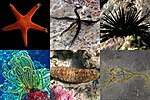Echinoderm (redirect from Phylum echinodermata)
(/ɪˈkaɪnəˌdɜːrm, ˈɛkə-/) is any deuterostomal animal of the phylum Echinodermata (/ɪˌkaɪnoʊˈdɜːrmətə/), which includes starfish, brittle stars, sea urchins...
77 KB (8,490 words) - 05:06, 7 May 2024
largest crinoid order, Comatulida. Crinoids are echinoderms in the phylum Echinodermata, which also includes the starfish, brittle stars, sea urchins and sea...
43 KB (4,559 words) - 15:27, 27 March 2024
PMC 2695056. PMID 19470464. Wagonner, Ben (1994). "Echinodermata: Fossil Record". Echinodermata. The Museum of Paleontology of The University of California...
105 KB (11,388 words) - 00:49, 17 May 2024
Peripodida) make up an unusual group of deep-sea taxa belonging to the phylum Echinodermata, with three species described in the genus Xyloplax. Intestine and anus...
2 KB (199 words) - 18:17, 15 December 2023
List of echinoderm orders (redirect from List of echinodermata orders)
species as well as the extinct species of the exclusively marine phylum Echinodermata. Subclass Articulata (540 species) Order Bourgueticrinida Order Comatulida...
10 KB (470 words) - 21:27, 18 May 2024
development. Deuterostomia is further divided into 4 phyla: Chordata, Echinodermata, Hemichordata, and the extinct Vetulicolia known from Cambrian fossils...
33 KB (3,164 words) - 20:06, 15 May 2024
Tafraout Group (section Echinodermata)
The Tafraout Group (Also "Tafraoute Group" or Zaouiat Ahançal Group) is a geological group of formations of Toarcian-Aalenian (Lower Jurassic-Middle Jurassic)...
127 KB (9,839 words) - 08:06, 26 May 2024
Articulata (Crinoidea) (redirect from Articulata (Echinodermata))
(2017-02-22). "Phylogenetic taxonomy and classification of the Crinoidea (Echinodermata)". Journal of Paleontology. 91 (4): 829–846. doi:10.1017/jpa.2016.142...
6 KB (653 words) - 03:12, 19 July 2023
Protozoa, Porifera, Coelenterata, Platyhelminthes, Nematoda, Annelida, Echinodermata, Mollusca and Arthropoda. Arthropoda include insects, crustaceans and...
41 KB (4,736 words) - 13:47, 20 May 2024
Lepocrinites is a genus of rhombiferan blastoids (Echinodermata). "ART. XXXV.--A New Cystid from the Clinton Formation of Ontario--Lepadocystis clintonensis"...
708 bytes (32 words) - 01:23, 18 November 2023
(sea cucumbers) are one of five extant classes that make up the phylum Echinodermata. This is one of the most distinctive and diverse phyla, ranging from...
60 KB (6,679 words) - 03:41, 19 May 2024
The largest animal currently alive is the blue whale. The maximum recorded weight was 190 tonnes for a specimen measuring 27.6 metres (91 ft), whereas...
161 KB (16,210 words) - 18:05, 27 May 2024
relatives of the Chordates are believed to be the Hemichordates and Echinodermata, which together form the Ambulacraria. The Chordata and Ambulacraria...
52 KB (4,756 words) - 00:15, 29 May 2024
through invagination of the endoderm. The main deuterostome phyla are the Echinodermata and the Chordata. Echinoderms are exclusively marine and include starfish...
125 KB (11,168 words) - 17:32, 27 May 2024
List of troglobites (section Echinodermata)
A troglobite (or, formally, troglobiont) is an animal species, or population of a species, strictly bound to underground habitats, such as caves. These...
17 KB (1,548 words) - 14:46, 12 May 2024
O'Hara, T.D.; Thuy, B. (2012). "Global diversity of brittle stars (Echinodermata: Ophiuroidea)". PLOS ONE. 7 (3): e31940. Bibcode:2012PLoSO...731940S...
33 KB (3,546 words) - 15:47, 25 March 2024
term typically used in the context of anatomical parts of the phylum Echinodermata or class Asteroidea and Edrioasteroidea. Echinoderms can have ambulacral...
2 KB (208 words) - 22:13, 1 October 2023
helianthoides. Podia of a sea cucumber (Holothuria forskali) "Morphology". Echinodermata. University of California Museum of Paleontology. Mah, Christopher L...
4 KB (410 words) - 05:36, 29 May 2024
Paleobiota of the Burgess Shale (section Echinodermata)
Echinodermata Genus Class Abundance Notes Images Gogia Eocrinoidea Six specimens This echinoderm was a primitive member of the eocrinoid group (which...
72 KB (1,446 words) - 18:35, 16 April 2024
Antarctic feather star species complex Promachocrinus 'kerguelensis' (Echinodermata: Crinoidea)". Invertebrate Systematics. 37 (7): 498–527. doi:10.1071/IS22057...
3 KB (304 words) - 17:55, 7 December 2023
been used as protective amulets. Sea urchins are members of the phylum Echinodermata, which also includes sea stars, sea cucumbers, sand dollars, brittle...
74 KB (7,702 words) - 16:11, 22 May 2024
List of animal classes (section Echinodermata (starfish, sea urchins, sand dollars, sea lilies, and others))
The following is a list of the classes in each phylum of the kingdom Animalia. There are 107 classes of animals in 33 phyla in this list. However, different...
8 KB (503 words) - 09:28, 29 April 2024
Rya Formation (section Echinodermata)
The Rya Formation (Swedish: Ryaformationen) is a geologic formation in Skåne County, southern Sweden. It is Early to early Middle Jurassic (early Sinemurian...
86 KB (5,490 words) - 23:55, 9 November 2023
central nervous system of these species from a study of, "Neurobiology of Echinodermata", which contain acetylcholine and dopamine/ noradrenaline.These are...
11 KB (1,059 words) - 19:21, 23 May 2024
Nusplingen Limestone (section Echinodermata)
The Nusplingen Limestone (German: Nusplingen Plattenkalk) is a geological formation in Baden-Württemberg, Germany. It preserves fossils dating to the Kimmeridgian...
19 KB (1,022 words) - 23:37, 15 May 2024
"Paedomorphosis, Aristotle's lantern, and the origin of the sand dollars (Echinodermata: Clypeasteroida)". Paleobiology. 16 (1): 25–48. Bibcode:1990Pbio...16...
15 KB (1,570 words) - 23:10, 15 April 2024
"Reproductive cycles of Diadema setosum and Echinometra mathaei (Echinoidea: Echinodermata) from Kuwait (Northern Arabian Gulf)". Bulletin of Marine Science. 67...
14 KB (1,610 words) - 21:39, 31 March 2024
23, 2018. Miller, J. E.; Pawson, David L., Swimming Sea Cucumbers (Echinodermata: Holothuroidea): A Survey, with Analysis of Swimming Behavior in Four...
8 KB (771 words) - 17:05, 18 February 2024
invertebrates: Echinodermata. McGraw-Hill Book Company Inc., New York. Jordan, A.J. 1972. On the ecology and behavior of Cucumaria frondosa (Echinodermata: Holothuroidea)...
7 KB (800 words) - 20:54, 23 August 2022
The smallest organisms found on Earth can be determined according to various aspects of organism size, including volume, mass, height, length, or genome...
46 KB (5,139 words) - 06:56, 19 May 2024























